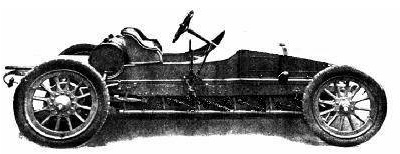|

The Ariel motorcar, then and
now.
The original tube frame Ariel Motorcar entered production in England in
1904, with a leather cone clutch and a top speed of approximately 30 mph. It
featured one of the automotive world's first tube frame chassis, a full 30
years before the Italians coined the term "superleggera" when they
incorporated tube frames into their highly successful race cars in 1937. The
original Ariel chassis was very lightweight, and so afforded the car very
good performance for its day. But the chassis was also unfortunately
structurally inadequate, and did not compete well in the sports car market.
Ariel scrapped the idea of a tube frame car in 1906 for the more popular
stamped steel chassis. There are those who speculate whether Ariel might
have done better in the automobile market had they succeeded with their tube
frame innovations as they had with their invention of the pneumatic tire. As
it was, Ariel made several more attempts at car design, including some
noteworthy 2-seaters, but increasingly shifted focus to their growing
motorcycle business, for which they abandoned the car market entirely in
1926.
Then, in 2000, nearly a century after the first Ariel tube frames came and
went, engineer turned entrepreneur Simon Saunders revived the Ariel name
with a hot rod version of the original Ariel. The result is sold as the
Ariel Atom, a minimalist tube frame roadster true to the original in
appearance, but with distinctly modern design elements, and a more than
adequate (thank you very much) tube frame chassis.

Saunders' new Ariel factory didn't market the Atom as a replica car, but
rather a road-going sports car. Its success in Europe and more recently the
US hinged instead on its status as a minimalist, streetable sports car in
its purest form. But its similarity to the original 1904 car has attracted
the attention of a growing cadre of historic automotive hobbyists determined
to drive a hotrodded piece of British automotive history. Simon Saunders did
an excellent job replicating the tube frame theme, the open wheel design,
the two seat doorless and roofless cockpit, and the spoked wheel pushed to
the corners of the car. Since fewer than 100 1904 Ariels were made, and none
are known to survive, the resemblance of today's Ariel replica to the
historical original roadster is lost to most people. But this modern replica
is the inevitable next step of a new British invasion: the revival of the
British historical sports car. From the redesigned new Mini Cooper to retro
entries by MG and Morgan, to Caterham's Lotus 7 replicas, and now a hot rod
based on the original tube frame Ariel, the market has shown resurgent
interest in these retrospective marvels.
The most common question from curious onlookers seems to be "how fast does
it go?". Depending on engine type, the top speed of 135 to 155 mph is
soundly mediocre by today's sports car standards, so a more impressive
answer might be its acceleration or cornering speed. But perhaps the best
response to how fast the Ariel tube frame motorcar goes is this: 0 to 60 mph
in 100 years.
- Researched and contributed
by Atom enthusiast Toby (thanks!). For additional information, check out the
Ariel page on
Wikipedia.
|
![]()

